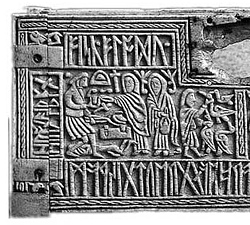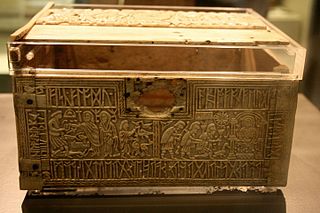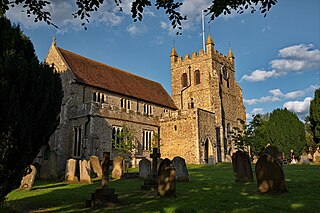 W
WAnglo-Saxon paganism, sometimes termed Anglo-Saxon heathenism, Anglo-Saxon pre-Christian religion, or Anglo-Saxon traditional religion, refers to the religious beliefs and practices followed by the Anglo-Saxons between the 5th and 8th centuries AD, during the initial period of Early Medieval England. A variant of Germanic paganism found across much of north-western Europe, it encompassed a heterogeneous variety of beliefs and cultic practices, with much regional variation.
 W
WBeowa, Beaw, Bēow [beːow], Beo or Bedwig is a figure in Anglo-Saxon paganism associated with barley and agriculture. The figure is attested in the Anglo-Saxon royal genealogies as they were extended in the age of Alfred, where Beowa is inserted as the son of Scyld and the grandson of Sceafa, in lineages carried back to Adam. Connections have been proposed between the figure of Beowa and the hero Beowulf of the poem of the same name and English folk song figure John Barleycorn.
 W
WBlót is the term for "Blood sacrifice" in Norse paganism. A blót could be dedicated to any of the Norse gods, the spirits of the land, and to ancestors. The sacrifice involved aspects of a sacramental meal or feast.
 W
WThe 17th act of the Anglo-Saxon poem Beowulf includes Beowulf's fight with a dragon, the third monster he encounters in the epic. On his return from Heorot, where he killed Grendel and Grendel's mother, Beowulf becomes king of the Geats and rules wisely for fifty years until a slave awakens and angers a dragon by stealing a jeweled cup from its lair. When the angry dragon mercilessly burns the Geats' homes and lands, Beowulf decides to fight and kill the monster personally. He and his thanes climb to the dragon's lair where, upon seeing the beast, the thanes flee in terror, leaving only Wiglaf to battle at Beowulf's side. When the dragon wounds Beowulf fatally, Wiglaf slays it.
 W
WThe Franks Casket is a small Anglo-Saxon whale's bone chest from the early 8th century, now in the British Museum. The casket is densely decorated with knife-cut narrative scenes in flat two-dimensional low-relief and with inscriptions mostly in Anglo-Saxon runes. Generally reckoned to be of Northumbrian origin, it is of unique importance for the insight it gives into early Anglo-Saxon art and culture. Both identifying the images and interpreting the runic inscriptions has generated a considerable amount of scholarship.
 W
WHarrow on the Hill is a locality and historic village in the borough of Harrow in Greater London, England. Independent boutiques and restaurants dot the affluent area, which is rich with historic architecture; offering a village atmosphere. The name refers to Harrow Hill, 408 feet (124 m). It is located some half a mile south from the modern town of Harrow. Harrow School is located in the area.
 W
WA heathen hof or Germanic pagan temple was a temple building of Germanic religion; a few have also been built for use in modern heathenry. The term hof is taken from Old Norse.
 W
WKirkharle is a hamlet in the county of Northumberland in Northern England located about 12 miles (19 km) west of the town of Morpeth, just to the west of the crossroads of the A696 and B6342 roads. It is famous as the birthplace of Lancelot 'Capability' Brown in the early eighteenth century.
 W
WThroughout its history the Kingdom of Mercia was a battleground between conflicting religious ideologies.
 W
WSpong Hill is an Anglo-Saxon cemetery site located at North Elmham in Norfolk, England. It is the largest Early Anglo-Saxon burial site ever excavated. The site at Spong Hill consisted of two cemeteries, a large cremation cemetery and a smaller, 6th century cemetery of 57 inhumations. Several of the inhumation graves were covered by small barrows and others were marked by the use of coffins.
 W
WSutton Hoo near Woodbridge, in Suffolk, England, is the site of two early medieval cemeteries that date from the 6th to 7th centuries. Archaeologists have been excavating the area since 1939. One cemetery had an undisturbed ship burial with a wealth of Anglo-Saxon artefacts; most of these objects are now held by the British Museum. Scholars believe Rædwald of East Anglia to be the most likely the person buried in the ship. The site is important in understanding the Anglo-Saxon kingdom of East Anglia and the early Anglo-Saxon period, as it illuminates a period that lacks historical documentation.
 W
WSymbel (OE) and sumbl (ON) are Germanic terms for "feast, banquet".
 W
WThundersley is a district and an ecclesiastical parish based on a manor of early origin in the north of the Castle Point Borough, in southeast Essex, England. The settlement, between the size of a typical village and town, is clustered and sits on clay ridge shared with Basildon and Hadleigh, 31 miles east of Charing Cross, London.
 W
WThursley is a village and civil parish in southwest Surrey, west of the A3 between Milford and Hindhead. An associated hamlet is Bowlhead Green. To the east is Brook. In the south of the parish rises the Greensand Ridge, in this section reaching its escarpment near Punch Bowl Farm and the Devil's Punch Bowl, Hindhead.
 W
WA thyle was a member of the court associated with Scandinavian and Anglo-Saxon royalty and chieftains in the Early Middle Ages, whose precise role is uncertain but probably had to do with the preservation of knowledge of the past and the judging of present statements against it.
 W
WThe Tribe of Witches: The Religion of the Dobunni and Hwicce is a historical and archaeological study of pre-Christian religion among the Iron Age Dobunni and the Early Medieval Hwicce, two tribal groups who lived in central England. It was written by the archaeologist Stephen J. Yeates and published by Oxbow Books in 2008. Yeates had previously published his theories in a three-volume British Archaeological Report monograph entitled Religion, Community and Territory: Defining Religion in the Severn Valley and Adjacent Hills from the Iron Age to the Early Medieval Period (2006).
 W
WWeedon Lois is a village in Weston and Weedon civil parish, about 5.5 miles (9 km) west of Towcester, Northamptonshire, England.
 W
WWeeley is a village and civil parish in Tendring, east Essex, England. The population of the parish at the 2011 Census was 1,768. It is served by Weeley railway station on the Sunshine Coast Line. It has bus links to Clacton-on-Sea and Colchester.
 W
WWelbeck Hill is the site of Roman and early Saxon pottery finds, and an Anglo-Saxon cemetery, located around 1.75 miles from Laceby, and around 3 miles from Riby, in North East Lincolnshire, England.
 W
WA wight is a creature or living sentient being. In its original usage, the word wight described a living human being, but has also come to be used within fantasy to describe certain undead. The earliest example of this usage in English is in William Morris's translation of the Grettis Saga, wherein haugbui is translated as "barrow-wight". Wights also feature in J. R. R. Tolkien's world of Middle-earth, especially in The Lord of the Rings, and in George R. R. Martin's HBO television series Game of Thrones and novel series A Song of Ice and Fire. Since its 1974 inclusion in the RPG Dungeons & Dragons (D&D), it has become a recurring form of undead in other fantasy games and mods, such as Vampire: The Masquerade.
 W
WWing, known in antiquated times as Wyng, is a village and civil parish in Aylesbury Vale district in Buckinghamshire, England. The village is on the main A418 road between Aylesbury and Leighton Buzzard. It is about 8 miles (13 km) north east of Aylesbury, 3 miles (5 km) west of Leighton Buzzard, and 12 miles (19 km) south of Milton Keynes.
 W
WWye is an historic village in Kent, England, centred 12 miles (19 km) from Canterbury, and is also the main village in the civil parish of Wye with Hinxhill. The population of the ward was 2,282 in 2011. It was home to London University's agricultural college until 2009, which was internationally famous for developing new varieties of hops such as Wye Challenger. In March 2013 the village was voted 3rd best place to live in the UK by The Sunday Times.
 W
WWyrd is a concept in Anglo-Saxon culture roughly corresponding to fate or personal destiny. The word is ancestral to Modern English weird, which retains its original meaning only dialectically.